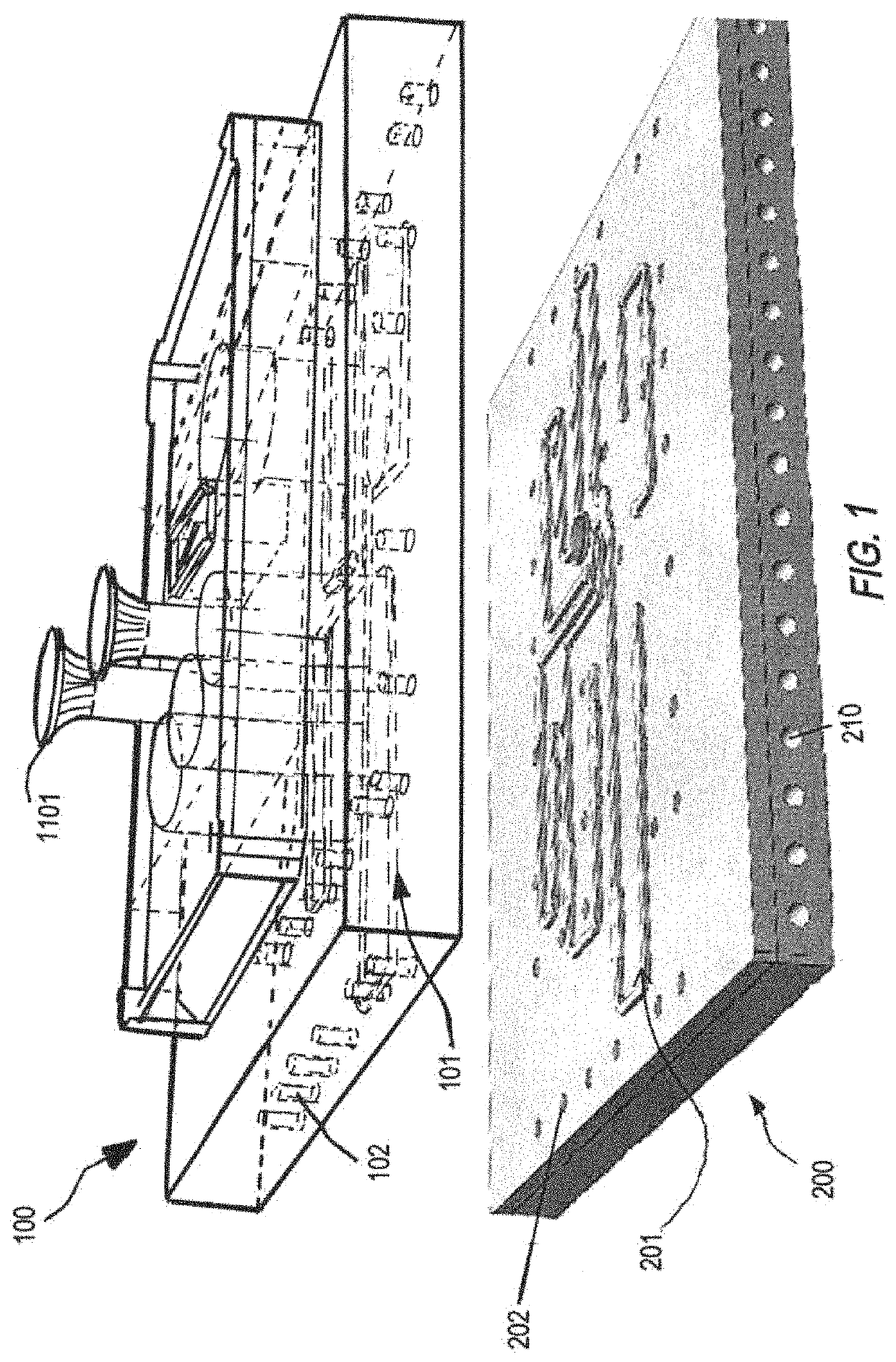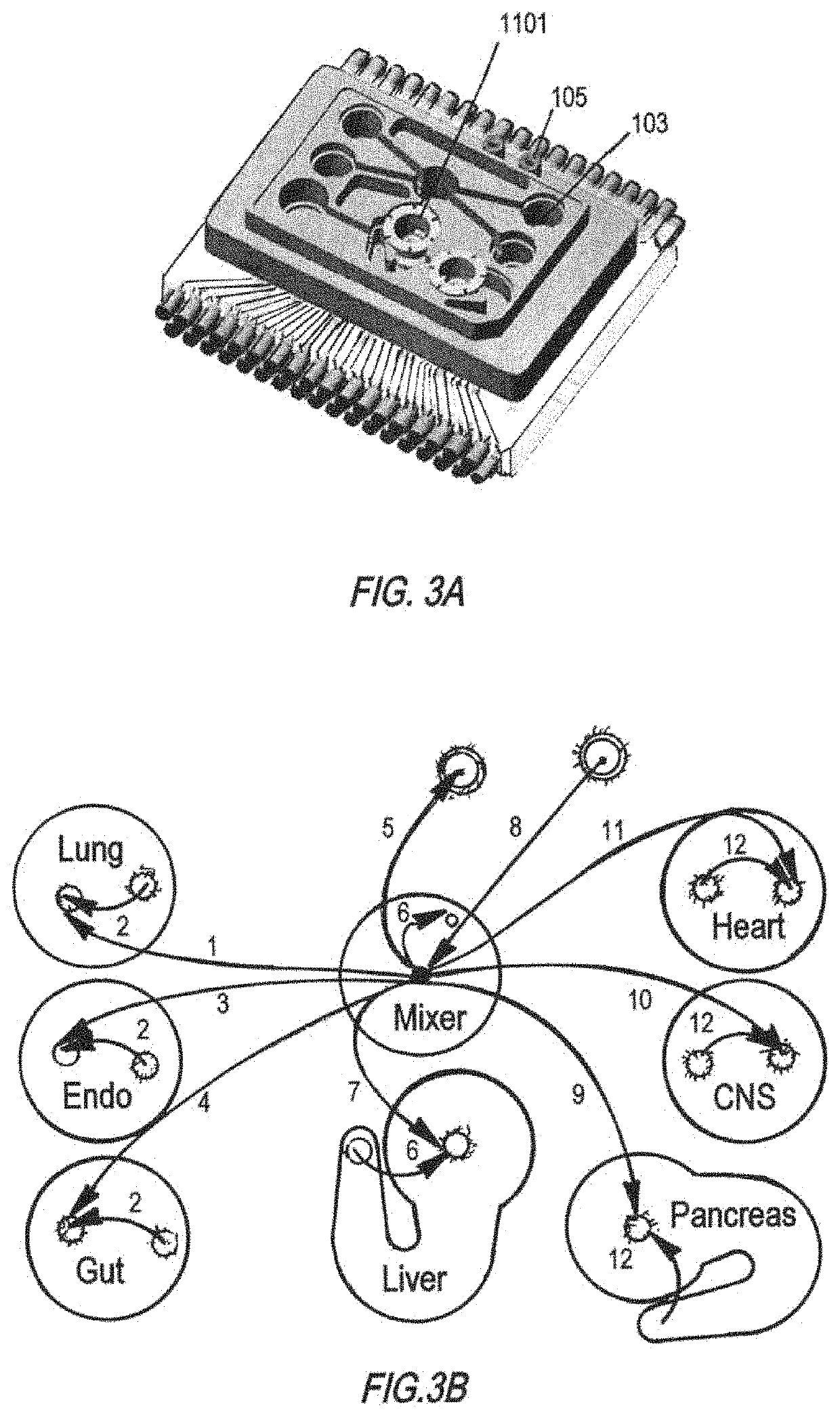Modular organ microphysiological system with integrated pumping, leveling, and sensing
a microphysiological system and organ technology, applied in the field of modules of organ microphysiological systems with integrated pumping, leveling, and sensing, can solve the problems of lack of clinical efficacy, inability to accurately diagnose and treat disease conditions, and insufficient animal models for recapitulating polygenic and multifactorial human diseases with diverse clinical phenotypes, etc., to achieve convenient cleaning and sterilization, reduce manufacturing time and cost, and improve reliability
- Summary
- Abstract
- Description
- Claims
- Application Information
AI Technical Summary
Benefits of technology
Problems solved by technology
Method used
Image
Examples
embodiments
[0143]FIG. 31 illustrates the spillway exit with a undercut beneath the exit, and vertical groove for anti-siphon effect.
[0144]Wall-bound drops that are pinned on an edge of a planar wall are generally referred to as wall-edge bound drops. Wall-Edge bound drops are typically found in nature as dew hanging from the leaves of plants until a sizable volume is reached and the drop falls. When drops are pinned on a pointed wall edge, they are referred to as wall-edge-vertex-bound drops. Wall-edge-vertex-bound drop simulations show liquid interfaces in contact with highly wetting solid walls (forming a spillway exit) tend to drip as the angle decreases. This is because the energy decrease from wetting the walls is greater than the energy of the liquid-air interface, such that the contact area wants to expand indefinitely in corners with smaller angles where thin fluid filaments form. The creation of a thin fluid filament is relevant and desirable in situations where accurate control of fl...
example 1
Single-Organ Microphysiological Systems (MPSs) on the Chip
(1) Liver: Perfused, Coculture of Hepatocyte-Kupffer to Three Weeks
Materials and Methods
[0264]Metabolic and immunologically competent 3D cryopreserved human hepatocytes and kupffer cells were cocultured. Multiple hepatocyte and Kupffer cell donors have been qualified in the MPS. Co-cultures were responsive to Lipopolysaccharide (LPS) stimulus down to 0.01 μg / ml.
Results
[0265]Table 1 shows the comparison of hepatocytes only and coculture of hypatocyte and Kupffer cells at a 10:1 ratio over 7 days in a perfused MPS platform.
[0266]
TABLE 1Biological function of liver cells vs. immune-competent liver MPS.HepatocyteHepatocyte +Function at Day 7 (n = 3)OnlyKupffer (10:1)Albumin (μg / day / mg)35 ± 1153 ± 32Urea (μg / day / mg)175 ± 75 184 ± 25 CYP3A (pmol / min / mg)2.9 ± 0.52.0 ± 0.7
[0267]The secretions of interleukin 6 (IL-6) and tumor necrosis factor alpha (TNFα) of the cocultured liver MPS were measured. The reproducibility of IL-6 response ...
example 2
t of Drug Toxicity in Individual or 2-Way MPS on the Chip
(1) Liver / Immune: Toxicities of Diclofenac and Tolcapone
[0278]An immune-competent liver MPS model was prepared and studied. Diclofenac impaired liver functions while cell death was minimal. Tolcapone decreased mitochondrial activity and caused cell death.
(2) Gut / Immune: Toxicities of Diclofenac and Tolcapone
[0279]An immune-competent gut MPS model was prepared and studied. Diclofenac reduced epithelial barrier integrity, causing leaky gut with a minimal cell death. Tolcapone led to severe cellular death, hence a complete loss of epithelial function.
(3) Endometrium MPS: Toxicities of Diclofenac and Tolcapone
[0280]An endometrium MPS model was prepared and studied. Diclofenac-induced loss of function correlating with cellular death. Tolcapone induced loss of function correlating with cellular death.
(4) Gut-Liver 2-Way: Administration of Tolcapone to Gut (“Oral”) Results in Gut-Specific Toxicity
Materials & Methods
[0281]An immune-co...
PUM
| Property | Measurement | Unit |
|---|---|---|
| frequencies | aaaaa | aaaaa |
| frequencies | aaaaa | aaaaa |
| volume | aaaaa | aaaaa |
Abstract
Description
Claims
Application Information
 Login to View More
Login to View More - R&D
- Intellectual Property
- Life Sciences
- Materials
- Tech Scout
- Unparalleled Data Quality
- Higher Quality Content
- 60% Fewer Hallucinations
Browse by: Latest US Patents, China's latest patents, Technical Efficacy Thesaurus, Application Domain, Technology Topic, Popular Technical Reports.
© 2025 PatSnap. All rights reserved.Legal|Privacy policy|Modern Slavery Act Transparency Statement|Sitemap|About US| Contact US: help@patsnap.com



